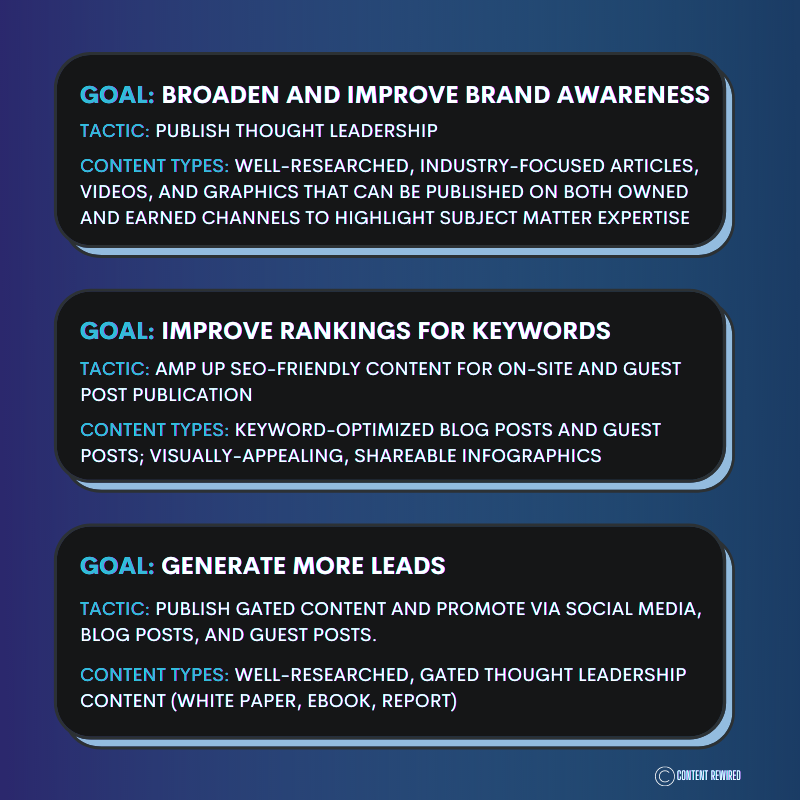For most fintechs, a content calendar is little more than a tactical sheet of reminders about what content is to be published and when. It outlines the topics, dates, cadence, and keywords – but entirely overlooks the strategic facets of content marketing.
It’s time for organizations to broaden their perspective on content calendars beyond a simple schedule for publishing content. Instead, it can be a strategic roadmap to achieve all the objectives you laid out in creating your content marketing plan.
The beauty of this approach is that it enables you to adapt your plan in real-time and use data and metrics to inform on-the-fly changes that promise better performance. How do you do this? Let’s find out.
Step 1: Remember Your Goals
When you embarked on your content marketing journey, you documented your goals. Some organizations that are just getting started may have created “big picture” goals for the year. Others with more mature content marketing programs may break down goals into quarterly bites. The latter is especially helpful in laying out your strategic fintech content calendar because it lets you get granular in your execution and how that maps back to your objectives.
With your goals in hand, consider the best content tactics to achieve them. For example:

Step 2: Outline Execution
A basic content calendar will outline content types, titles, and channels, but there’s a lot more behind-the-scenes work that goes into making all of that happen. Namely, there are people who write, edit, film, inform, and finalize each content piece that comes into existence.
What that means is that you have to consider your internal capacity to create content. Who is on your content team? How many pieces can each person reasonably produce each week or month? Who else is involved in content creation? Are there third-party people who play a role in content production? These are all important things to consider – and include in your content calendar.
Why include these details? For one, it aids in collaboration. When you specify who needs to be involved on which pieces and how, everyone is clear on their roles, responsibilities, and timelines. Additionally, if you have a pool of subject matter experts that you can work with, it’s helpful for everyone to know who those people are and exactly how they are available to contribute.
It can be good to understand their availability upfront and to document this in your calendar. Perhaps you have an executive who can dedicate six hours per month to content projects. If you can interview that person in thirty minutes, that enables you to use them for up to 12 pieces of content. That impacts your content calendar.
Between SMEs and your in-house content team, you should have a solid idea about how much content you have the capacity to create each month. Use that to guide your strategic fintech content calendar creation.
Step 3: Flesh it Out
You know your goals and your capacity. Now it’s time to document how you’ll use the latter to reach the former. The first part of this is determining your content mix. Look back at your goals to get a sense of the different types of content you’ll need to produce, whether they’re blog posts, guest posts, thought leadership articles, white papers, ebooks, infographics, videos, or something else.
Then evaluate your capacity and determine how much of each content type you’ll be able to produce each month. Obviously written content is simpler to produce than video content, so you may need to tinker around will resource allocation to best meet your content needs.
As an example, let’s look at what a team might expect for content mix in a month where lead generation is the primary goal:
- Two gated pieces of content (one ebook and one report)
- One drip campaign for each gated piece of content (two total), consisting of a five-email sequence
- 16 Blog posts (8 for each piece of gated content) that touch on a different topic or sub-topic from each gated content piece
- Eight guest posts to earn backlinks on sites related to the subject matter of the gated content
If you’ve made it through the first three steps, you’re well on your way to creating a strategic fintech content calendar. Next week, we’ll walk through a few more steps to complete your calendar, so stay tuned.



